This is an old revision of this page, as edited by 2604:6000:1115:545:d5e2:ab01:7c1:594d (talk) at 20:48, 8 February 2020. The present address (URL) is a permanent link to this revision, which may differ significantly from the current revision.
Revision as of 20:48, 8 February 2020 by 2604:6000:1115:545:d5e2:ab01:7c1:594d (talk)(diff) ← Previous revision | Latest revision (diff) | Newer revision → (diff) This article is about the town in Germany. For other uses, see Görlitz (disambiguation). Place in Saxony, Germany
| This article needs additional citations for verification. Please help improve this article by adding citations to reliable sources. Unsourced material may be challenged and removed. Find sources: "Görlitz" – news · newspapers · books · scholar · JSTOR (February 2017) (Learn how and when to remove this message) |
You can help expand this article with text translated from the corresponding article in German. (May 2016) Click for important translation instructions.
|
| Görlitz | |
|---|---|
| Town | |
  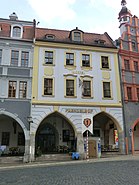   From top: View over Görlitz,
From top: View over Görlitz,inside Görlitz Department Store, Untermarkt (market square), Landeskrone (Sedło) mountain, Upper Lusatian Library of Sciences (Oberlausitzische Bibliothek der Wissenschaften) | |
 Coat of arms Coat of arms | |
Location of Görlitz within Görlitz district
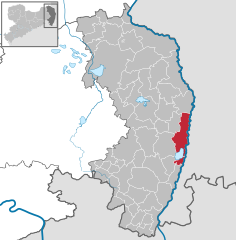 | |
  | |
| Coordinates: 51°09′10″N 14°59′14″E / 51.15278°N 14.98722°E / 51.15278; 14.98722 | |
| Country | Germany |
| State | Saxony |
| District | Görlitz |
| Subdivisions | 10 town- and 8 village-quarters |
| Government | |
| • Mayor | Octavian Ursu |
| Area | |
| • Total | 67.22 km (25.95 sq mi) |
| Elevation | 199 m (653 ft) |
| Population | |
| • Total | 56,574 |
| • Density | 840/km (2,200/sq mi) |
| Time zone | UTC+01:00 (CET) |
| • Summer (DST) | UTC+02:00 (CEST) |
| Postal codes | 02826–02828 |
| Dialling codes | 03581 |
| Vehicle registration | GR, LÖB, NOL, NY, WSW, ZI |
| Website | goerlitz |
Görlitz (Template:IPA-de; Upper Lusatian dialect: Gerlz, Gerltz, and Gerltsch, Template:Lang-pl, Template:Lang-hsb, Template:Lang-dsb, Template:Lang-cz) is a town in the German federal state of Saxony. Located in the region of Lusatia on the Lusatian Neisse River, it is the second largest town in Lusatia after Cottbus, and the largest in Upper Lusatia. Seat of the district of Görlitz, Germany's easternmost district, its approximately 56,000 inhabitants also make Görlitz the sixth largest town of the Free State of Saxony. It lies opposite the Polish town of Zgorzelec, which was part of Görlitz until 1945. While not Lusatiophone itself, the town lies just east of the Sorbian-speaking parts of Lusatia.
From 1815 until 1918, Görlitz belonged to the Province of Silesia in the Kingdom of Prussia, and later to the Province of Lower Silesia in the Free State of Prussia. It is the largest town of the former Province of Lower Silesia that lies west of the Oder-Neisse line and hence remains in Germany today. Thus it is both the most Silesian town, in terms of character, and the largest in Germany today. The town combines Lusatian and Silesian traditions as well as German and Sorbian culture. Görlitz has a rich architectural heritage. Many movie-makers have used the various sites as locations.
History
Historical affiliationsDuchy of Poland 1002–1025
Kingdom of Poland 1025–1031
Margraviate of Meissen 1032–ca. 1072
Duchy of Bohemia ca. 1072–1198
Kingdom of Bohemia 1198–1253
Margraviate of Brandenburg 1253–1319
Duchy of Jawor 1319–1329
Kingdom of Bohemia 1329–1466
Kingdom of Hungary 1466–1490
Kingdom of Bohemia 1490–1635
Electorate of Saxony 1635–1697
Poland-Saxony 1697–1706
Electorate of Saxony 1706–1709
Poland-Saxony 1709–1763
Electorate of Saxony 1763–1806
Kingdom of Saxony 1806–1815
Kingdom of Prussia 1815–1871
German Empire 1871–1918
Weimar Republic 1918–1933
Nazi Germany 1933–1945
Allied-occupied Germany 1945–1949
East Germany 1949–1990
Germany 1990–present

As a small Sorbian village named Gorelic in the region of Upper Lusatia in the March of Lusatia of the Holy Roman Empire, it was temporarily conquered and held by the Kingdom of Poland during Bolesław I Chrobry's invasion of Lusatia between 1002 and 1031, after which the region fell back to the March of Lusatia under the counts of the Margraviate of Meissen. Around 1072 the village was assigned to the duchy of Bohemia. The date of the town's foundation is unknown. However, Goreliz was first mentioned in a document from the King of Germany, and later Holy Roman Emperor, Henry IV in 1071. This document granted Görlitz to the Diocese of Meissen, then under Bishop Benno of Meissen. Currently, this document can be found in the Saxony State Archives in Dresden. The origin of the name Görlitz is derived from the Slavic word for "burned land", referring to the technique used to clear land for settlement. Zgorzelec and Czech Zhořelec have the same derivation. In the 13th century the village gradually became a town. Due to its location on the Via Regia, an ancient and medieval trade route, the settlement prospered.
In the following centuries Görlitz was a wealthy member of the Lusatian League, which consisted of Bautzen, Görlitz, Kamenz, Lauban, Löbau and Zittau. In 1352 during the reign of Casimir the Great, Lusatian German colonists from Görlitz founded the town of Gorlice in southern Poland near Kraków.

The Protestant Reformation came to Görlitz in the early 1520s and by the last half of the 16th century, it and the surrounding vicinity, became almost completely Lutheran.
After suffering for years in the Thirty Years' War, the region of Upper Lusatia (including Görlitz) was ceded to the Electorate of Saxony in 1635. After the Napoleonic Wars, the 1815 Congress of Vienna transferred the town from the Kingdom of Saxony to the Kingdom of Prussia. Görlitz was subsequently administered within the Province of Silesia, and, after World War I, the Province of Lower Silesia, until 1945.
Near the end of World War II, German troops destroyed all bridges crossing the Lusatian Neisse. The redrawing of boundaries in 1945—in particular the relocation of the German-Polish border to the present Oder-Neisse line—divided the town. The right bank became part of Poland and was renamed Zgorzelec by the Polish communist government in 1948, while the main portion on the left bank remained part of Germany, now within the state of Saxony. When the East German states were dissolved in 1952, Görlitz became part of the Dresden District, but the states were restored upon German reunification in 1990.
On 27 June 1994, the town became the seat of the Roman Catholic Diocese of Görlitz, but it remains a Lutheran Protestant stronghold.
In 2002 Lake Berzdorf, located south of Görlitz on the site of a former opencast lignite mine, began to fill; it is now much used for recreation, besides being of wildlife value. The Altstadtbrücke (literally old town bridge) between Görlitz and sister city Zgorzelec was rebuilt between 2003 and 2004. It was officially opened on 20 October 2004. As soon as Poland signed the Schengen Agreement (20 December 2007), movement between the two banks of the river again became unrestricted, since border controls were eliminated. Indeed, users of the new pedestrian bridge are not told by any signs that they are leaving one country and entering another.
Whilst the town was well preserved, it was notably grey and colourless under communist East German rule. Since reunification, and as of 2013, over 700 buildings have been renovated. It is a popular place to which the elderly of Germany retire, being quiet and relatively affordable by German standards. Its tourist potential is rapidly expanding, being very much an eastern counterpart to towns such as Heidelberg. In the case of Görlitz, much of the funding for the renovation of the town's buildings came from an anonymous donor who, from 1995 to 2016, sent an annual donation of about €500,000, totalling over €10,000,000.
Arts and culture

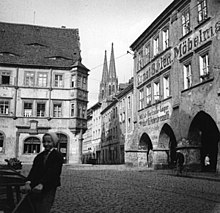
Today Görlitz and Zgorzelec, two towns on opposite banks of the narrow river, get along well. Two bridges have been rebuilt, a bus line connects the German and Polish parts of the town, and there is a common urban management, with annual joint sessions of both town councils.
The town has a rich architectural heritage (Gothic, Renaissance, Baroque, Neoclassical, Art Nouveau). One example of this rich architectural heritage is the Schönhof, which is one of the oldest civic Renaissance buildings in Germany. Another medieval heritage is a model of the Holy Sepulchre (de) which was constructed in the late 15th century.
In 2006 the twin city Görlitz/Zgorzelec applied to be the European City of Culture 2010. It was hoped that the concept of Polish-German cooperation would be sufficient to convince the jury, but Essen won. Görlitz was placed second. As a result of the campaign Görlitz was renamed City of Culture in order to further German-Polish relations and to attract tourists from all over the world.
As Görlitz was part of Silesia from 1815 onward, it has a Silesian Museum dedicated to the region (Schlesisches Museum zu Görlitz) and even holds a Silesian Music festival (Schlesisches Musikfest). In addition, Görlitz is the seat of the Silesia Youth Group (Schlesische Jugend). There is also a newspaper in Görlitz called the Lower Silesian Kurier (Niederschlesischer Kurier).
Görlitz is also the birthplace of the German version of nonpareils, popularly known in Germany as liebesperlen (German: love pearls). Invented by confectioner Rudolf Hoinkis (1876–1944), the name derives from a conversation Hoinkis had with his wife, proclaiming his love for her like these "pearls", the nonpareil. Unsure of what to call the treat he invented, his wife suggested calling them love pearls, and the name stuck. The factory where he first manufactured the treat, founded in 1896, is now run by his great-grandson, Mathias.
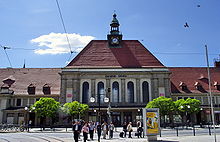
Transport
Görlitz station is on the Berlin – Görlitz and the Dresden – Görlitz lines of Deutsche Bahn. The station also provides an international connection to Wrocław, Poland.
Local public transport is provided by:
- The Verkehrsgesellschaft Görlitz (VGG) provides public transport service in the city, including the Görlitz tramway and bus services.
- The Przedsiębiorstwo Komunikacji Samochodowej (PKS) provides bus service over the river between Görlitz and its sister city, Zgorzelec.
Film location

Due to the historical parts of the city, many movie-makers have used the various sites as locations. Eli Roth shot the movie-in-a-movie Stolz der Nation (Pride of the Nation) for Quentin Tarantino's Inglourious Basterds (which incidentally purports to be Sicily) on the Untermarkt and Obermarkt in Görlitz' oldest parts of the city. Other films shot in Görlitz include the 2013 war drama The Book Thief and the teen years in The Reader. Görlitz was used as the primary shooting location for the Wes Anderson film The Grand Budapest Hotel, with Görlitz standing in for a resort in the fictional Eastern European country of Zubrowka. A vacant department store in the city was redecorated to serve as the hotel itself.
Twin towns - sister cities
See also: List of twin towns and sister cities in GermanyGörlitz is twinned with:
 Amiens, France
Amiens, France Molfetta, Italy
Molfetta, Italy Nový Jičín, Czech Republic
Nový Jičín, Czech Republic Wiesbaden, Germany
Wiesbaden, Germany Zgorzelec, Poland
Zgorzelec, Poland
Being the easternmost town in the country, Görlitz has formed a "Compass Alliance" (Zipfelbund) with the northernmost, westernmost, and southernmost towns, List, Selfkant, and Oberstdorf respectively. They participate in the annual German Unity Day celebrations to represent the modern limits of Germany.
Notable people

- Michael Ballack (born 1976), football player
- Jakob Böhme (1575–1624), mystic and theologian
- Johann Christoph Brotze (1742–1823), educator
- Hans Georg Dehmelt (1922–2017), co-recipient of 1989 Nobel Prize in Physics
- Hans-Jürgen Dörner (born 1951), football player and coach
- Werner Finck (1902–1978), comedian, actor and writer
- Agnes Fingerin (d. 1514), phialntrophist and businessperson
- Richard Foerster (classical scholar) (1843–1922), classical scholar
- Johann Carl Gehler (1732–1796) physician, anatomist and mineralogist
- Johann Gottlob Harrer (1703–1755), composer
- Torsten Gütschow (born 1962), football player
- Herbert Hirche (1910-2002), architect and designer
- Hanna von Hoerner (1942–2014), astrophysicist
- Emil Jannings (1884–1950), first actor to win the Academy Award for Best Actor
- Jens Jeremies (born 1974), football player
- Reinhart Koselleck (1923–2006), historian
- Michael Kretschmer (born 1975), politician (CDU)
- Lars Kaufmann (born 1982), handball player
- Olivier Messiaen (1908–1992), musician, professor of harmony at the Paris Conservatoire
- Oskar Morgenstern (1902–1977), economist
- Gustavus Adolphus Neumann (1807–1886), publisher
- Arthur Pohl (1900–1970), set designer, director and screenwriter
- Pavle Jurišić Šturm (1848–1922), Serbian Army general
- Alfred Wagenknecht (1881–1956), American Marxist politician.
- Giorgio Zur (born 1930), Catholic Archbishop and Apostolic Nuncio in Austria
Climate
The climate is oceanic (Köppen: Cfb) or on the western edge of humid continental (Dfb) by the 0 °C isotherm. In other words, the climate is still marine but relevant influence of the continentality. Its location in the far east of Germany and further away from the sea gives a climate with lower performance of the west winds although still present until the western half of Poland. Summers can be warm, though not as much as the southern continent and the winters are cold and snowy, although it does not remain all winter.
| Climate data for Görlitz, 1981–2010 normals | |||||||||||||
|---|---|---|---|---|---|---|---|---|---|---|---|---|---|
| Month | Jan | Feb | Mar | Apr | May | Jun | Jul | Aug | Sep | Oct | Nov | Dec | Year |
| Mean daily maximum °C (°F) | 1.8 (35.2) |
3.1 (37.6) |
7.6 (45.7) |
13.5 (56.3) |
18.7 (65.7) |
21.2 (70.2) |
23.7 (74.7) |
23.4 (74.1) |
18.4 (65.1) |
13.1 (55.6) |
6.5 (43.7) |
2.6 (36.7) |
12.8 (55.1) |
| Mean daily minimum °C (°F) | −3.2 (26.2) |
−2.6 (27.3) |
0.5 (32.9) |
3.7 (38.7) |
8.1 (46.6) |
11.1 (52.0) |
13.1 (55.6) |
12.8 (55.0) |
9.6 (49.3) |
5.7 (42.3) |
1.5 (34.7) |
−1.9 (28.6) |
4.9 (40.8) |
| Average rainfall mm (inches) | 45.7 (1.80) |
37.3 (1.47) |
49.2 (1.94) |
40.0 (1.57) |
57.6 (2.27) |
65.8 (2.59) |
86.6 (3.41) |
80.0 (3.15) |
53.4 (2.10) |
40.3 (1.59) |
49.2 (1.94) |
50.7 (2.00) |
655.8 (25.83) |
| Mean monthly sunshine hours | 62.8 | 78.8 | 120.9 | 179.2 | 223.6 | 210.5 | 228.2 | 220.3 | 152.7 | 124.9 | 62.9 | 50.1 | 1,714.9 |
| Source: Météoclimat | |||||||||||||
| Climate data for Görlitz (near the Goerlitz Airstrip), elevation: 238 m, 1961-1990 normals and extremes | |||||||||||||
|---|---|---|---|---|---|---|---|---|---|---|---|---|---|
| Month | Jan | Feb | Mar | Apr | May | Jun | Jul | Aug | Sep | Oct | Nov | Dec | Year |
| Record high °C (°F) | 14.3 (57.7) |
15.9 (60.6) |
22.5 (72.5) |
30.2 (86.4) |
30.0 (86.0) |
32.7 (90.9) |
35.7 (96.3) |
34.0 (93.2) |
32.1 (89.8) |
26.0 (78.8) |
18.4 (65.1) |
15.3 (59.5) |
35.7 (96.3) |
| Mean daily maximum °C (°F) | 0.9 (33.6) |
2.7 (36.9) |
7.1 (44.8) |
12.6 (54.7) |
18.0 (64.4) |
21.2 (70.2) |
22.8 (73.0) |
22.6 (72.7) |
18.6 (65.5) |
13.3 (55.9) |
6.5 (43.7) |
2.5 (36.5) |
12.4 (54.3) |
| Daily mean °C (°F) | −1.5 (29.3) |
−0.4 (31.3) |
3.2 (37.8) |
7.6 (45.7) |
12.6 (54.7) |
15.8 (60.4) |
17.3 (63.1) |
16.9 (62.4) |
13.6 (56.5) |
9.2 (48.6) |
3.9 (39.0) |
0.2 (32.4) |
8.2 (46.8) |
| Mean daily minimum °C (°F) | −4.0 (24.8) |
−3.1 (26.4) |
−0.1 (31.8) |
3.3 (37.9) |
7.6 (45.7) |
10.9 (51.6) |
12.4 (54.3) |
12.0 (53.6) |
9.5 (49.1) |
5.8 (42.4) |
1.5 (34.7) |
−2.1 (28.2) |
4.5 (40.0) |
| Record low °C (°F) | −27.5 (−17.5) |
−23.7 (−10.7) |
−18.2 (−0.8) |
−5.6 (21.9) |
−2.6 (27.3) |
0.2 (32.4) |
4.8 (40.6) |
4.1 (39.4) |
−0.4 (31.3) |
−5.0 (23.0) |
−14.7 (5.5) |
−21.0 (−5.8) |
−27.5 (−17.5) |
| Average precipitation mm (inches) | 47.0 (1.85) |
37.0 (1.46) |
38.0 (1.50) |
50.0 (1.97) |
66.0 (2.60) |
70.0 (2.76) |
70.0 (2.76) |
74.0 (2.91) |
52.0 (2.05) |
45.0 (1.77) |
51.0 (2.01) |
57.0 (2.24) |
657 (25.88) |
| Average precipitation days (≥ 1.0 mm) | 10.0 | 9.0 | 9.0 | 10.0 | 10.0 | 10.0 | 10.0 | 10.0 | 9.0 | 7.0 | 10.0 | 12.0 | 116 |
| Mean monthly sunshine hours | 55.8 | 76.0 | 120.8 | 157.5 | 213.8 | 210.5 | 221.7 | 209.7 | 153.6 | 126.8 | 57.9 | 45.1 | 1,649.2 |
| Source: NOAA | |||||||||||||
Gallery
-
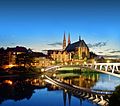 St. Peter and Paul church and the river Lusatian Neisse in Görlitz
St. Peter and Paul church and the river Lusatian Neisse in Görlitz
-
 Interior of St. Peter and Paul with its Sonnenorgel (sun organ)
Interior of St. Peter and Paul with its Sonnenorgel (sun organ)
-
 The Schönhof, the oldest Renaissance building in Görlitz
The Schönhof, the oldest Renaissance building in Görlitz
-
 Interior of the Görlitzer Warenhaus department store
Interior of the Görlitzer Warenhaus department store
-
 View over Obermarkt taken from Reichenbacher Turm
View over Obermarkt taken from Reichenbacher Turm
-
 Old town hall
Old town hall
-
 Royal coats of arms of Hungarian King Matthias Corvinus (Old Town Hall)
Royal coats of arms of Hungarian King Matthias Corvinus (Old Town Hall)
-
 New town hall
New town hall
-
 Reichenbacher Turm
Reichenbacher Turm
-
 Typical Gründerzeit buildings in Görlitz
Typical Gründerzeit buildings in Görlitz
-
 The Landeskrone
The Landeskrone
-
 View over Görlitz old town
View over Görlitz old town
-
 Panorama over Zgorzelec taken from Görlitz
Panorama over Zgorzelec taken from Görlitz
See also
References
- "Einwohnerzahlen nach Gemeinden als Excel-Arbeitsmappe" (XLS) (in German). Statistisches Landesamt des Freistaates Sachsen. 2024.
- Heinz, Marlis (30 November 2015). "Hier dreht sich alles um das Drehen". morgenpost.de. Retrieved 7 April 2017.
- "Deutschlands Städte, Gemeinden und Kreise online - FindCity". findcity.de. Archived from the original on 20 May 2007. Retrieved 7 April 2017.
- "Placenames of the World" by Adrian Room, McFarland Pub. 2003 page 140
- "Görlitz' Generous Donor". dw.com. Deutsche Welle. 23 April 2013. Retrieved 1 May 2017.
- "Görlitz erhält die letzte "Altstadtmillion"". Die Welt. 7 April 2016.
{{cite web}}: Cite has empty unknown parameter:|1=(help) - "Nonpareil - sweet treat from Görlitz". dw.com. Deutsche Welle. 28 April 2016. Archived from the original on 1 December 2017. Retrieved 1 May 2017.
- "Willkommen" (in German). Verkehrsgesellschaft Görlitz GmbH. Retrieved 20 February 2015.
- "Informacje bieżące" [Current Information] (in Polish). Polnische Verkehrsgesellschaft (Polish Transport Company). Archived from the original on 10 March 2012. Retrieved 23 June 2010.
- Duke, Alan (11 August 2009). "'Basterds' pro-Nazi short made by a Jewish director - CNN.com". CNN. Retrieved 7 April 2017.
- "'Newcomer Görlitz', das Stadtportrait für das MYSELF Magazin - Fotos Christian KERBER c/o SOLAR UND FOTOGRAFEN". Gosee (in German). 22 April 2016. Retrieved 7 April 2017.
- "Wes Anderson's new movie has a distributor, plot". The A.V. Club. 28 March 2013. Retrieved 7 April 2017.
- "Städtepartnerschaften". goerlitz.de (in German). Görlitz. Retrieved 2 December 2019.
- "Gorlitz, Germany Köppen Climate Classification (Weatherbase)". Weatherbase. Retrieved 1 February 2019.
- "Görlitz (10499) - WMO Weather Station". NOAA. Retrieved 1 February 2019.
External links
 Görlitz travel guide from Wikivoyage
Görlitz travel guide from Wikivoyage- Official website
 (in German)
(in German) - DW-World 'trial living' report.
- DW-World A New Yorker in Görlitz. Begins at 26:13.
- "Görlitz/Zgorzelec – Urban development from 12th to 21st century" on YouTube
- (in Polish) Zgorzelice in the Geographical Dictionary of the Kingdom of Poland (1895)
